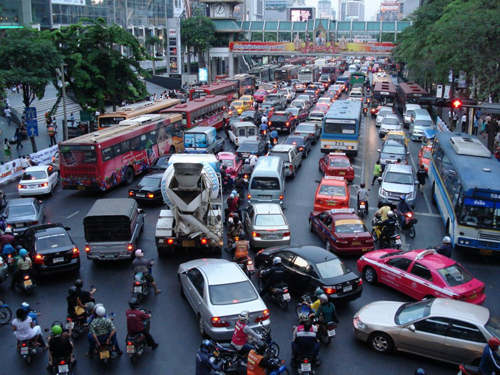Production of passenger vehicles (cars and light trucks) rose from 74.4 million in 2010 to 76.8 million in 2011—-and 2012 may bring an all-time high of 80 million or more vehicles. Global sales of passenger vehicles increased from 75.4 million to 78.6 million over the same period, with a projected 81.8 million in 2012, writes report author and Worldwatch Senior Researcher Michael Renner. The major driver of increased production and sales are the so-called emerging economies, especially China.
Rising sales translate into ever-expanding fleets. An estimated 691 million passenger cars were on the world’s roads in 2011. When both light- and heavy-duty trucks are included, the number rises to 979 million vehicles, which was 30 million more than just a year earlier. By the end of 2012, the global fleet could top 1 billion vehicles—-one for every seven people on the planet.
Electric vehicle (EV) production remains at barely perceptible levels. Although several countries have issued targets for future EV fleets, it remains to be seen whether these goals can be met. China, for instance, wants to put 5 million plug-in hybrid-electric and fully electric vehicles on its roads by 2020—-which could account for more than 40 percent of the global EV fleet that year. An analysis by Deutsche Bank Climate Advisors, however, suggests that production of 1.1 million EVs and a fleet of 3.5 million in China is a more realistic projection.
“Automobiles are major contributors to air pollution and greenhouse gas emissions,” said Renner. “Greater fuel efficiency, along with the use of cleaner fuels, can help mitigate these impacts, although increases in the numbers of cars and the distances driven threaten to overwhelm fuel economy advances.”
Discussions about reducing the environmental impacts of vehicles tend to focus on technical improvements, such as engines, aerodynamic design, and fuels—-yet another concern is the distances traveled. Even though the United States has just 25 percent of the total population of the group of wealthy nations known as the Organisation for Economic Co-operation and Development (OECD), in 2008 it alone accounted for just over 40 percent of the 10.3 trillion passenger-kilometers driven in all OECD member countries. Still, U.S. car travel is down slightly from its peak of 4.3 trillion passenger kilometers in 2005, to 4.1 trillion passenger kilometers in 2008.
Further highlights from the report:
- The passenger vehicle fleet in China grew at an annual average rate of 25 percent during 2000-11, from fewer than 10 million cars to 73 million cars.
- The top four producers of light vehicles—-China, the United States, Japan, and Germany—-together account for more than half of global output.
- Hybrid vehicles are growing in number, but they remain below 2 percent of total vehicle output.
- Car travel in non-OECD countries doubled between 1975 and 2000, but it then picked up pace by doubling again in just the decade to 2010.
